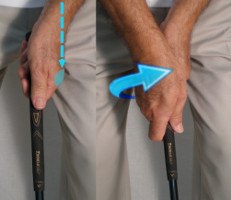Pros and Cons of Every Golf Grip Style |
Best Grip? Overlapping vs Interlocking |
Grip style: Vardon (overlapping) |
Hand position: Neutral |
Putting grip style / hand position: Reverse overlap / neutral
|

He’s easily recognized as a 6’0”, 230-pound professional golfer with a bald head and a goatee. Brendon de Jonge’s grip stands out, too.
So-called “mixed” grips, which combine elements of strong, weak and neutral positions, aren’t all that uncommon on the PGA TOUR. Thomas Bjorn and Angel Cabrera – both of whom mix a strong left hand with a neutral right – offer well-known examples. Few if any pros, however, exhibit a neutral left hand with a very weak right, a la de Jonge.
De Jonge’s left hand position isn’t unusual by itself. The back of his hand is nearly square to the target line in classic neutral fashion. But the right hand, well, that’s a different story. The “V” formed by de Jonge’s right thumb and forefinger points to the left of his sternum. Contrast that with a neutral right hand, where the “V” aligns with the handle, or the oft-seen-on-tour strong position, with “V” aimed at the right shoulder.
Obviously, de Jonge is doing something right. While he has yet to claim a tour victory as of early 2015, he compiled double-digit top-10 finishes each year from 2010-13.
How does he putt? About average for a pro. On the greens, Brendon de Jonge’s grip is pretty standard except for the large angle between the back of his left hand and wrist. This is due in part because he sets up with his hands directly aligned with the ball, rather than pressed slightly toward the target.
The idea is to maintain this cocked position throughout the stroke, limiting wrist motion as much as possible.














